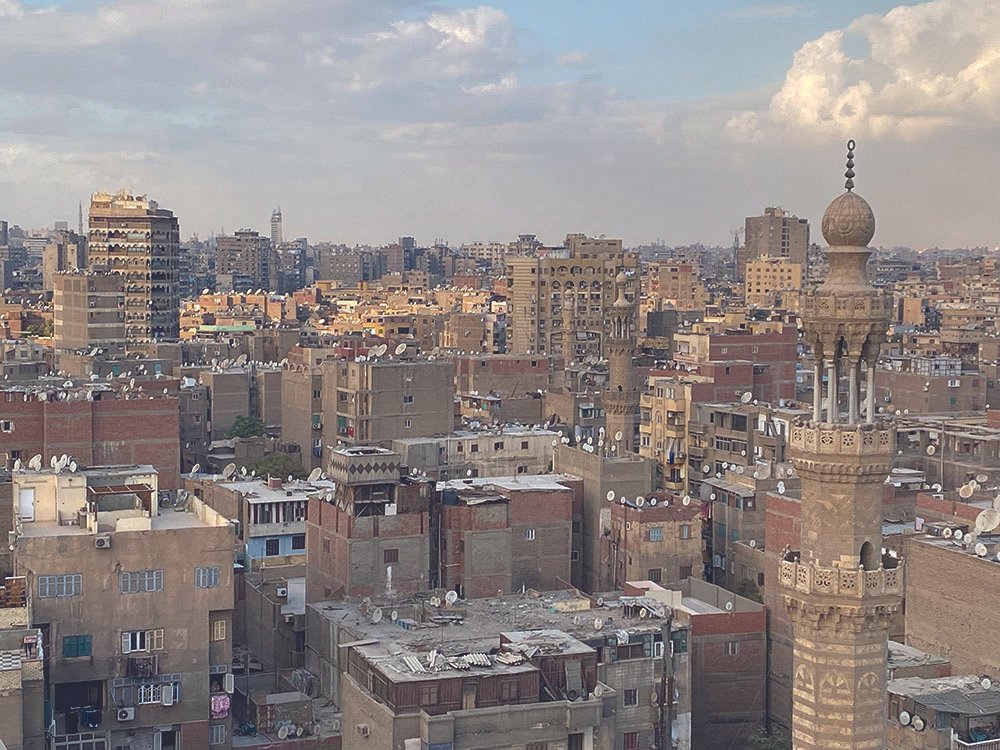A letter from Cairo
By COA Charles Eliot Chair in Ecological Planning, Policy, and Design Brook Muller
Al-Khalifa neighborhood from the tower of the Mosque of Ibn Tulun.
The setting: Late afternoon, early July, 2024. My friend and colleague May al-Ibrashy and I catch up while sitting under a trellis in a gathering area in the recently completed al-Khalifa Heritage and Environment Park. Kids chase each other on paths amidst birdsong, trees, and swings. The crippling heat of the city that surrounds us momentarily loses its hold, dissipating in the dusky smog.
In 2015, Cairo University architecture professor Nabil Elhady invited me to participate in a workshop focused on retrofits to low-cost, multi-family housing in 6th of October, a planned satellite city perched on the white desert plateau above the Nile Valley west of Cairo. We engaged CU students in systems-based design approaches for upgrading typical five-story, concrete and brick infill housing blocks to better suit the lifeways of those migrating from rural parts of Egypt (due to climate change impacts), with a focus on rooftop urban agriculture. One day during that first visit, Nabil introduced me to May, taking me to her studio in the al-Khalifa neighborhood of medieval Islamic Cairo, part of the Historic Cairo UNESCO World Heritage Site and readily locatable by the landmark ninth-century Mosque of Ibn Tulun (879 AD) marking the neighborhood’s northwest corner. A collaboration began shortly thereafter and continues to this day, including work on the park we now catch up in.
“Experiences in Cairo have engendered deep reflection on my role as an educator and what skills to nurture so students interested in design and community development have future agency in collaborating effectively in complicated, multilayered urban settings.”
May’s practice supports an impressive breadth of community development projects through a potent alignment of heritage conservation, urban ecological design, and the arts. Megawra Built Environment Collective and the associated Athar Lina (Heritage is Ours) initiative that she leads provide alternative models of practice for emerging Cairene designers. Khalifa Heritage and Environment Park intercepts groundwater from leaky pipes damaging two 13th century shrines across the street, buildings May and her team are working to restore. A novel approach intercepts the very medium causing harm to establish a much-needed open green space for women and children where nothing else like it exists. Given the enormous volumes of groundwater threatening heritage sites in al-Khalifa, far more than needed for the park, the team now investigates more comprehensive, neighborhood scale water reuse focused on the formation of a chain of “green pockets,” and down al-Khalifa Street, the neighborhood’s main arterial, mini park spaces in alleyways and on rooftops focus on urban food production and evaporative cooling features. Taking advantage of underutilized assets such as plentiful water and acres of rooftops in a highly constrained context, and deploying an economy of “moves” to achieve richness of effect: this is the challenge at hand in transposing ecological design strategies to the city.
The opportunity to apply systems-based design principles in this magical yet precarious place (May describes Cairo as “the sublime mess”) informs the ecological design research studios I teach at the College of the Atlantic. More broadly, experiences in Cairo have engendered deep reflection on my role as an educator and what skills to nurture so students interested in design and community development have future agency in collaborating effectively in complicated, multilayered urban settings. A key motivating question associated with this effort: How can a neighborhood of concrete and stone “regrow” as it confronts unprecedented change, climatic and otherwise? How can we vastly improve the environmental quality of urban settings while radically reducing energy and material consumption and extractive relationships with the nonurban settings—and peoples—that the city relies upon?
A related question energizes me: How can we use the privilege of time and space that a COA studio setting affords, not to mention the unique power of this institution’s human-ecological approach, to engage in research—on passive (natural) cooling or urban agriculture as examples—that might be helpful to our colleagues on the ground? How can we contribute to transforming the city site-by-site (vs. massive scale developmentalist projects), taking motivation from architect Sim van der Ryn’s famous claim that the socioecological problems we confront reflect a failure of design. What roles can we play in advancing low-cost, low-carbon, low-energy measures in jerry-rigging existing spaces and infrastructures to better support the lives of humans and nonhumans in times of great peril and change?
These questions speak to a larger, critical one, so central to the mission of COA: What is the value of collaboration involving multiple disciplines, and how do we engage in it effectively? Here I share with students lessons learned in over 30 years of creative practice, and yet especially as a function of ongoing work in Egypt. The outlook operates as follows: We each bring ideas and skills to a given situation or problem, and yet we are not solutionist geniuses, arriving with answers (alas, such was a prevailing attitude in the architectural culture I grew up within). It is precisely this humble approach that enables us to do good work as a collective and, in the process, for each of us to hone our sensibilities and find our voices. I can think of no higher form of ambition and no better way to advance, as the anthropologist Artur Escobar describes it, a place-based globalism, a networked manner of working committed to replenishment on the ground.
Brook Muller was named a Fulbright Specialist in 2024 in honor of his human-ecological architectural work in Cairo.




